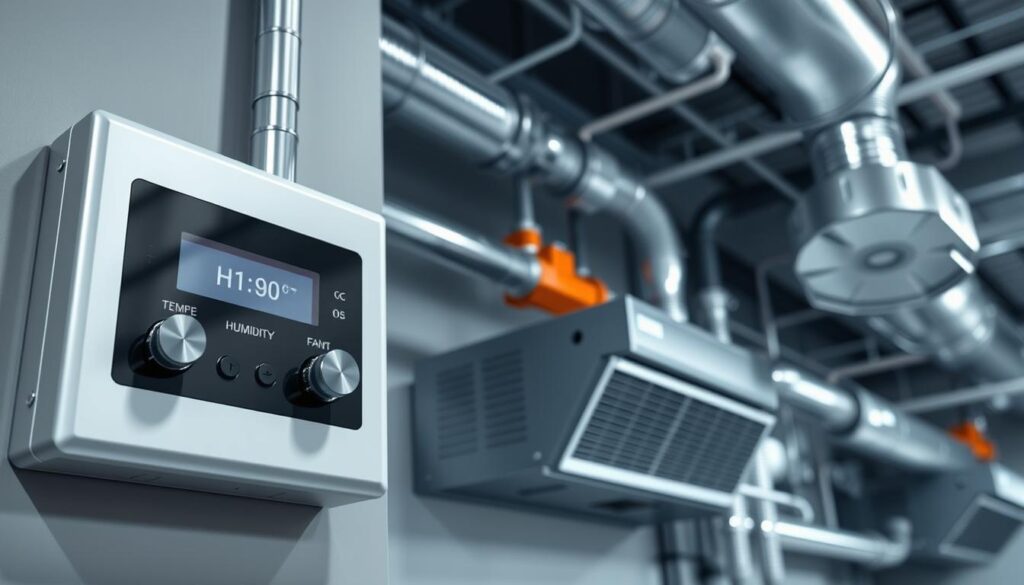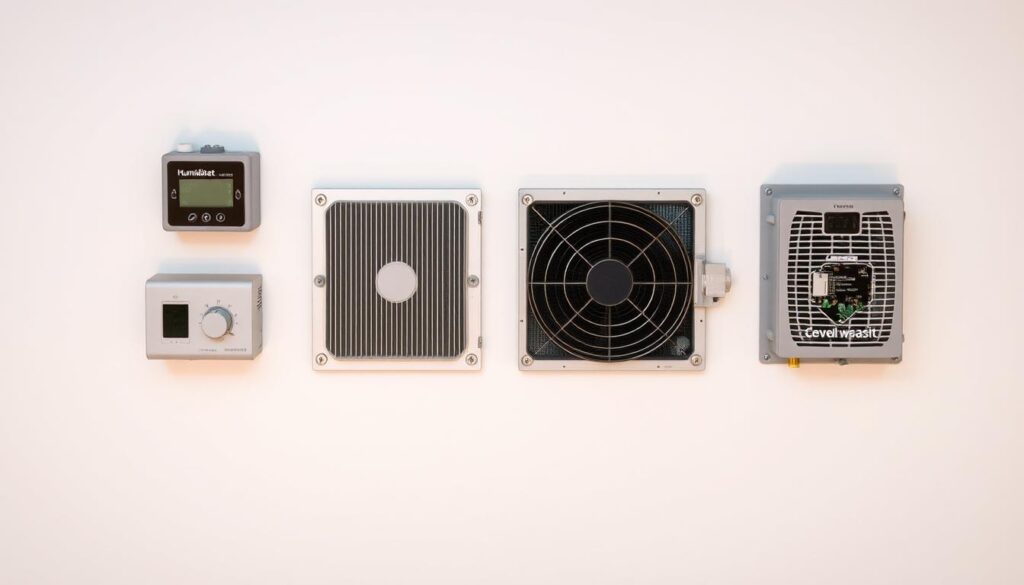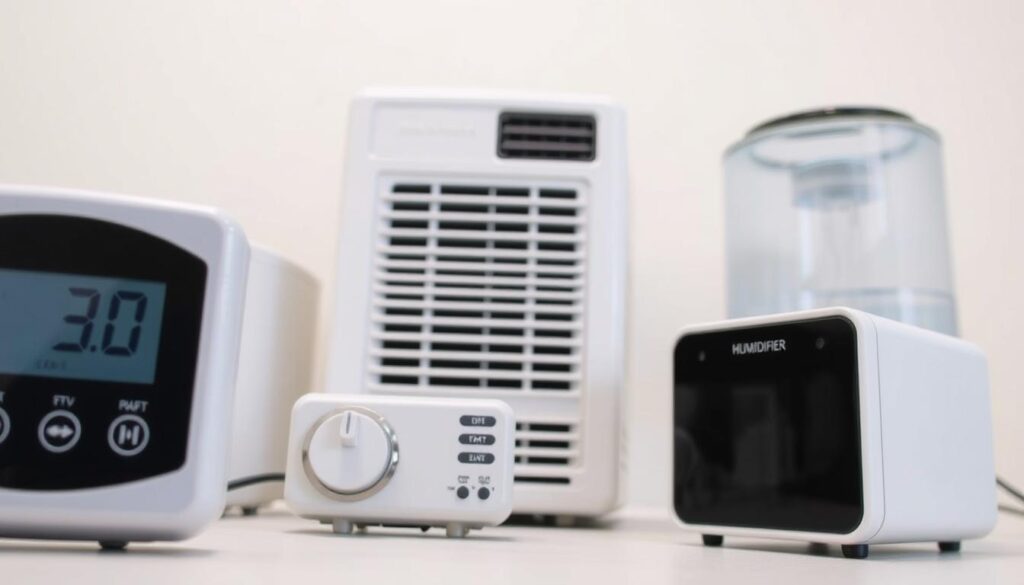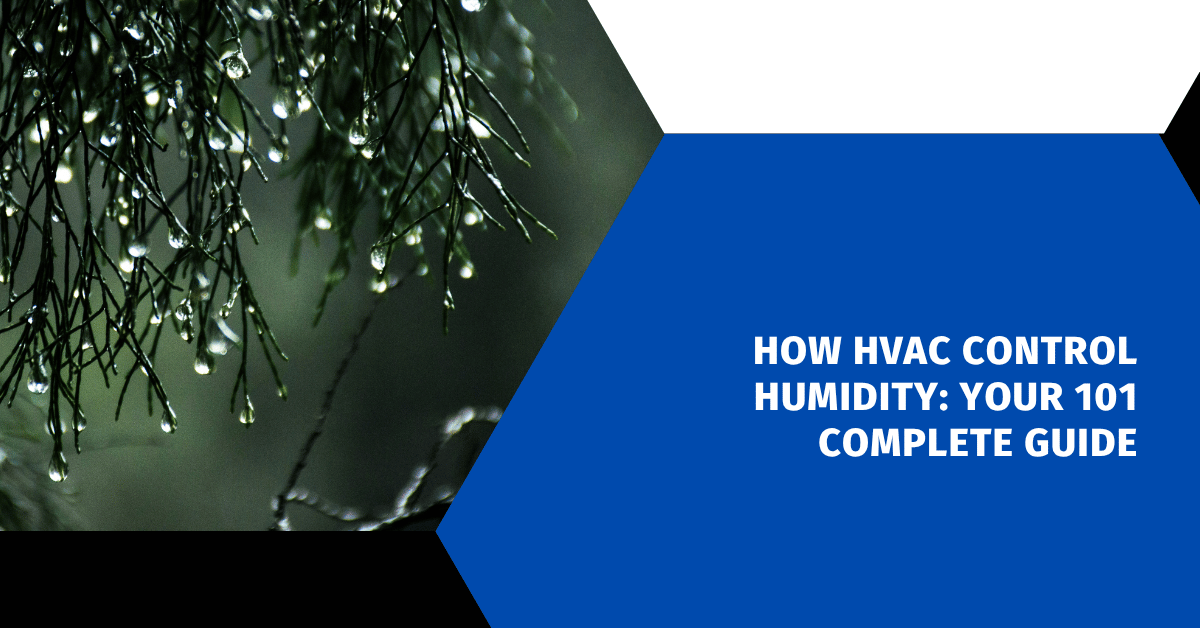Affiliate Disclosure
HVAC Guide Guys is a participant in the Amazon Services LLC Associates Program, an affiliate advertising program designed to provide a means for sites to earn advertising fees by advertising and linking to Amazon.
How HVAC Control Humidity? Are you tired of indoor humidity that’s hard to control? Learning about HVAC humidity control systems might change your home’s comfort and air quality.

Your home’s comfort isn’t just about temperature. It’s also about the right moisture levels. HVAC systems help keep these levels just right, usually between 40%-50% in summer.
Too much humidity can lead to viruses, bacteria, and mold. This can really hurt your indoor air quality. Using your HVAC system right can help manage moisture and make your home healthier.
Key Takeaways
- HVAC systems are key for indoor humidity control
- Optimal humidity is 40%-50% in summer
- Right humidity stops mold and bacteria
- Smart HVAC tech offers better moisture control
- Regular maintenance is vital for good humidity control
Table of Contents
Understanding the Basics of Indoor Humidity
Humidity is key to your home’s comfort and health. Knowing how moisture affects your space helps manage air quality better. This is done through humidity management with hvac systems.
Indoor humidity is more than a number. It shows the water vapor in the air. This affects how comfortable and healthy your home feels.
What is Relative Humidity
Relative humidity (RH) shows the moisture in the air. It compares to the air’s moisture capacity at a certain temperature. Most people find 40% to 60% RH comfortable.
- Below 30%: Air becomes too dry
- 30-50%: Ideal indoor humidity range
- Above 60%: Risk of moisture-related issues
Optimal Humidity Levels for Indoor Spaces
The Environmental Protection Agency (EPA) suggests keeping humidity between 30-50%. These levels change with the seasons:
| Season | Ideal Humidity Range |
|---|---|
| Winter | 30-45% |
| Summer | 40-50% |
Impact of Humidity on Comfort and Health
Your hvac dehumidification process affects indoor air quality. Wrong humidity levels can cause health and comfort problems:
- High humidity (above 60%) can cause:
- Mold and mildew growth
- Increased dust mite populations
- Respiratory complications
- Low humidity (below 30%) may lead to:
- Dry skin and irritation
- Increased static electricity
- Respiratory discomfort
“Maintaining proper humidity is not just about comfort, it’s about creating a healthy living environment.”
Understanding humidity basics helps manage indoor air quality. This makes your home more comfortable and healthy.
Explore Our HVAC Shop
Looking for top-rated HVAC tools, parts, and accessories? Visit our shop and find the perfect solution for your needs.
Visit the ShopThe Role of HVAC Systems in Humidity Control
Your HVAC system does more than just control temperature. It also plays a key role in managing indoor humidity. This ensures your home stays comfortable and healthy. Modern HVAC systems have advanced sensors for precise humidity control.
The main way HVAC systems control humidity is through cooling. When your air conditioner runs, it takes moisture out of the air. This happens through condensation. The system works by cooling air until it reaches its dew point, causing water vapor to condense and drain away.
“Controlling indoor humidity is not just about comfort, it’s about creating a healthy living environment.”
- Ideal indoor humidity ranges between 30-50%
- HVAC systems remove excess moisture during cooling
- Humidity sensors help maintain optimal levels
- Proper drainage prevents moisture buildup
Different HVAC systems have their own ways of controlling humidity. Central air conditioners, heat pumps, and mini-split systems all have unique methods. The key is to ensure they are properly sized and installed for effective moisture management.
| HVAC System Type | Humidity Control Efficiency |
|---|---|
| Central Air Conditioner | High |
| Heat Pump | Moderate to High |
| Mini-Split System | Moderate |
Understanding how your HVAC system manages humidity can help you optimize its performance. This ensures a comfortable indoor environment all year round.
How HVAC Control Humidity: The Complete Process
Learning about HVAC systems and how they manage humidity is fascinating. They do more than just cool the air. They also control moisture levels in your home.
The Condensation Process
The hvac dehumidification process starts with a cool science fact. Warm, humid air meets cold evaporator coils in your HVAC system. This makes the air condense, like water on a cold glass on a hot day.
- Warm air is pulled through return vents
- Air passes over refrigerant-filled evaporator coils
- Coils cool the air below its dew point
- Water vapor transforms into liquid droplets
The Role of Evaporator Coils
Evaporator coils play a key role in controlling humidity. They cool the air, making it perfect for moisture removal. As refrigerant flows through the coils, it takes heat from the air. This causes water vapor to turn into liquid.
Moisture Removal and Drainage Systems
Once moisture condenses, it needs to be removed. A special drainage system keeps water out of your HVAC unit. Water collects in condensate pans and is then drained outside your home.
“Effective humidity control is not just about comfort, but about maintaining a healthy indoor environment.” – HVAC Experts
Modern HVAC systems can cut indoor humidity by up to 30% in the best conditions. This greatly improves your home’s air quality and comfort. Understanding this process shows how advanced technology keeps your home comfortable and healthy.
Explore Our HVAC Shop
Looking for top-rated HVAC tools, parts, and accessories? Visit our shop and find the perfect solution for your needs.
Visit the ShopCommon Causes of High Indoor Humidity
Knowing why your indoor humidity is high is key to keeping it just right. High humidity can make your home feel uncomfortable and even harm your health.
Many things can make your indoor moisture levels too high:
- Outdoor weather conditions
- Poor home ventilation
- Daily household activities
- Structural vulnerabilities
Outdoor weather greatly affects your home’s humidity. Energy Star says air leaks can waste up to 40% of your home’s energy. This lets humid air get into your home.
“Controlling indoor humidity is not just about comfort, it’s about protecting your home and health.”
Your daily activities also add to indoor moisture. Cooking, showering, and laundry all release a lot of water vapor. Without good air flow, this moisture can lead to mold and mildew.
| Humidity Source | Moisture Impact |
|---|---|
| Cooking | High steam generation |
| Showering | Significant moisture release |
| Laundry | Moderate humidity increase |
Structural problems like bad window seals, foundation cracks, and poor insulation also add moisture. A good hvac system can help by controlling air quality and stopping moisture buildup.
To keep your home’s humidity at the right level, you need to know these common causes. Then, you can find ways to fix them and keep your home healthy.
The Impact of HVAC System Size on Humidity Control
Your HVAC system is key to keeping your home’s humidity in check. Choosing the right size is essential for a comfortable and healthy home. Knowing how system size impacts humidity control helps you make better choices for your home’s climate.
Finding the right size for your HVAC system isn’t just about picking the biggest one. Each home has its own needs based on different factors.
Problems with Oversized Units
An oversized HVAC unit can lead to big humidity problems:
- Rapid cooling without removing enough moisture
- System cycles on and off too quickly
- Higher energy bills
- Uneven heating and cooling
“A system that’s too large doesn’t run long enough to effectively remove moisture from the air” – HVAC Experts
Issues with Undersized Systems
An undersized HVAC system has its own set of issues:
- Runs constantly without reaching the right temperature
- Can’t control humidity well
- Wears out faster
- Costs more to run
Finding the Right Balance
To get the best humidity control, consider these important factors:
- Get professional load calculations
- Know your home’s specific needs
- Think about your local climate
- Seek advice from HVAC experts
The EPA says keeping indoor humidity between 30% and 50% is best for comfort and health. Picking the right HVAC system size is a big step towards this goal.
Explore Our HVAC Shop
Looking for top-rated HVAC tools, parts, and accessories? Visit our shop and find the perfect solution for your needs.
Visit the ShopEssential Components of HVAC Humidity Control

Knowing the main parts of HVAC humidity control helps keep your indoor space comfy and healthy. Your HVAC system needs key parts to handle moisture well.
The core of controlling humidity includes several important parts:
- Evaporator coils: Primary moisture removal mechanism
- Condensate pans: Collect water removed from air
- Drain lines: Direct moisture away from your system
- Humidity sensors: Monitor moisture levels
When installing an hvac humidifier, techs make sure these parts work together well. The evaporator coils cool the air, making water vapor condense. This lowers indoor humidity.
“Proper humidity control is not just about comfort, but about protecting your home and health.” – HVAC Professionals
To keep your dehumidifier working right, check these key parts often. Keeping humidity between 30% and 50% indoors stops mold and damage to materials.
| Component | Function | Maintenance Frequency |
|---|---|---|
| Evaporator Coils | Remove moisture from air | Annually |
| Condensate Pans | Collect water | Bi-annually |
| Drain Lines | Remove collected moisture | Quarterly |
Pro tip: Regular upkeep of these parts boosts your HVAC’s efficiency and life span.
Smart Technology and Humidity Management
Modern HVAC systems have changed how we enjoy our homes. They use smart tech to control humidity levels better than ever before.
Smart tech lets us manage our homes’ climate with great precision. It uses advanced sensors to keep humidity just right, so we don’t have to do much.
Modern Control Systems
Today’s HVAC systems can handle humidity like pros. They can:
- Watch humidity levels in real-time
- Change settings on their own
- Show detailed performance reports
- Help use less energy
Smart Thermostats and Humidity Sensors
Smart thermostats are a game-changer for controlling the climate. They have advanced sensors that track moisture levels, keeping your home just right.
Smart sensors bring many benefits, like:
- Tracking moisture levels accurately
- Making adjustments automatically
- Helping save energy
Automated Humidity Control Features
Modern HVAC systems can control humidity on their own. They adjust to changes in the environment. This can:
- Lower energy use by up to 30%
- Save 10-15% on cooling costs
- Stop mold and moisture problems
“Smart HVAC technology transforms how we manage indoor comfort, providing unprecedented control and efficiency.” – Climate Control Expert
Using these smart technologies makes your home more comfortable and energy-efficient. And it’s easy to do.
Explore Our HVAC Shop
Looking for top-rated HVAC tools, parts, and accessories? Visit our shop and find the perfect solution for your needs.
Visit the ShopMaintaining Your HVAC System for Optimal Humidity Control
Keeping your HVAC system in good shape is key to controlling humidity. Regular care makes sure it works well. This keeps your home comfortable and healthy.
Your HVAC system is vital for managing moisture indoors. If you ignore maintenance, you might face big problems:
- Less cooling power
- Higher energy bills
- Mold and mildew could grow
- Worse indoor air quality
Important maintenance steps include:
- Change air filters every 1-3 months
- Clean the evaporator coils often
- Make sure drainage systems are clear
- Look for moisture in ductwork
“Preventative maintenance can reduce HVAC energy consumption by up to 15% and extend system lifespan by 20-50%.”
It’s wise to get professional help at least once a year. Look out for signs your system needs a check-up, like:
- Uneven cooling
- Strange noises
- Too much moisture around vents
- Unexpected jumps in energy costs
Regular maintenance keeps your HVAC system in top shape. It controls humidity, improves air quality, and saves energy.
Integrating Supplemental Humidity Control Devices
Your HVAC system is key to managing indoor humidity. Sometimes, you might need extra help. Supplemental devices can improve air quality and comfort, even in tough conditions.

In humid areas, too much moisture can be a problem. It makes you feel uncomfortable and can harm your health. Knowing when and how to use extra humidity control devices is important.
Whole-House Dehumidifiers
Whole-house dehumidifiers are strong solutions for keeping your home dry. They remove moisture all over your house. This is better than portable units for tackling humidity.
- Integrated with existing HVAC systems
- Capacity range of 70-130 pints per day
- Energy-efficient options available
Portable Humidity Control Options
Portable devices are great for controlling humidity in specific spots. They’re flexible and work well in areas with constant moisture.
- Ideal for basements, crawl spaces, and bathrooms
- Capacity range of 30-90 pints per day
- Easy to move and install
When Additional Equipment is Necessary
Think about getting extra devices if:
- Indoor humidity is always over 60%
- You notice musty smells
- There’s mold visible
- Allergies or breathing problems get worse
“Effective humidity control is not just about comfort, but also about maintaining a healthy indoor environment.”
Understanding your home’s humidity needs and picking the right devices can make your living space healthier and more comfortable.
Explore Our HVAC Shop
Looking for top-rated HVAC tools, parts, and accessories? Visit our shop and find the perfect solution for your needs.
Visit the ShopTroubleshooting Common Humidity Control Issues
Managing your hvac humidity control system can be tough. It’s important for good indoor air quality. Spotting problems early helps keep your home comfy.
A well-maintained HVAC system is key to optimal humidity control.
Here are some common signs of trouble with your hvac system:
- Persistent condensation on windows
- Musty odors in living spaces
- Visible mold growth
- Unexplained dampness
Here are some steps to fix these issues:
- Check air seals around windows and doors
- Inspect evaporator coils for dirt buildup
- Verify proper system drainage
- Test humidity levels with a hygrometer
Humidity levels between 30% and 50% are best for comfort and health.
| Humidity Issue | Potential Cause | Recommended Action |
|---|---|---|
| Excessive Moisture | Oversized HVAC Unit | Professional system evaluation |
| Persistent Dampness | Air Leaks | Seal gaps, improve insulation |
| Inconsistent Humidity | Dirty Filters | Regular filter replacement |
If you can’t fix it yourself, get help from an HVAC expert. They can solve tough humidity problems in your home.
Energy Efficiency and Humidity Control
Knowing how humidity affects energy use can save you a lot on bills. Your HVAC system’s work is key to your home’s energy use. This is true when keeping humidity levels just right.
Too much humidity makes your cooling system work harder. This can increase energy use by up to 30%. It also shortens your HVAC’s life by 10-20%.
“Efficient humidity control is key to reducing energy waste and maintaining a comfortable home environment.”
- Ideal humidity ranges for energy efficiency: 30-50% relative humidity
- Dehumidification can consume 25-33% of cooling energy in humid climates
- Proper hvac system humidity regulation can reduce cooling costs
Smart ways to save energy include:
- Installing programmable thermostats
- Using zoning systems
- Regular HVAC maintenance
- Monitoring humidity levels weekly
Proactive humidity management can help you optimize your HVAC system’s performance and reduce energy consumption.
Conclusion
Knowing how HVAC controls humidity is key to a comfy and healthy home. Your HVAC system is important for managing moisture. This keeps your home safe and healthy.
For good humidity control, regular maintenance and the right system are essential. High humidity can cause energy waste, mold, and poor air quality. By following this guide, you can make your HVAC system work better.
Smart tech has changed how we control humidity, making it easier and more precise. Modern HVAC systems with advanced sensors keep humidity between 40% and 60%. This is vital for comfort, whether it’s too wet or too dry.
Act now to control your home’s humidity. Get regular HVAC checks, think about extra dehumidifiers, and use smart tech for humidity tracking. Your comfort, health, and energy savings depend on it.

